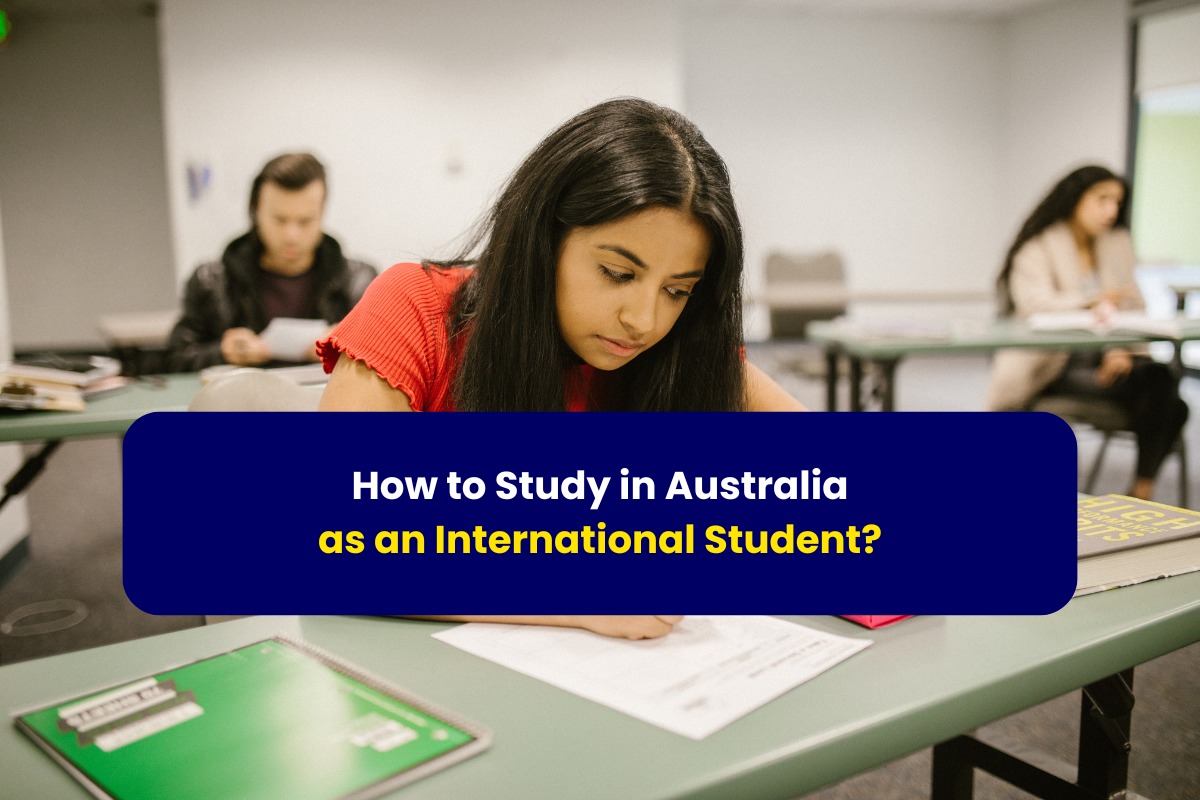How to Study in Australia as an International Student?

How to Study in Australia as an International Student?
How to study in Australia international student -it's a question many Indian students (and their parents) are asking right now. Should you leap? Is it worth it?
Whether you’ve just finished your 12th board exams or recently graduated from college, the dream of studying in Australia is more than getting a degree. It’s about building a better future, gaining global exposure, and maybe even settling down in a country that values talent and hard work.
But honestly, there’s a lot to figure out. That’s why we’ve made this guide to help you understand the process clearly, step by step. From choosing a course to getting your visa, we’re breaking it all down for you. Let’s get started.
Why Study In Australia?
Most applicants don’t know that Australia welcomes over 700,000 international students each year. And you know why they pick Australia?
It’s not the beaches or the weather. Australia ranks among the top 3 most popular study destinations globally. With world-class universities and student-friendly cities, it’s a smart choice for your future. Here’s why Australia should be your top choice when learning how to study in Australia as an international student.
Globally Respected Universities
Nine universities from Australia rank within the global top 100 as per QS WUR 2025. Institutions like the University of Melbourne, Australian National University (ANU), and the University of Sydney have set global benchmarks in research, teaching quality, and graduate outcomes.
Additionally, 95% of Australian universities are ranked globally. So, it is easier for you to select a reputable institution, no matter your area of study.
Student-Centric Cities
According to QS Best Student Cities 2025, Australia hosts 7 of the world’s top 50 cities for students. Most of the cities offer safe, affordable, and culturally rich places to live and study. These are-
-
Melbourne
-
Brisbane
-
Sydney
-
Adelaide
-
Perth
-
Canberra
Plus, with a high student visa approval rate of around 85%-87% for Indian students, getting there is very achievable.
Research Excellence
Australia contributes significantly to global research in areas like climate change, public health, engineering, and artificial intelligence. Whether you're pursuing postgraduate research or joining an innovation-driven undergrad program, you'll be immersed in a high-impact academic environment.
Real-World Curriculum
Australian universities offer internships, project-based learning, and strong industry partnerships. You’ll graduate with real experience and practical skills employers are looking for.
Culture and Lifestyle
Living in Australia means access to:
-
Vibrant urban life and beautiful natural landscapes
-
Friendly and diverse communities
-
Outdoor activities, cultural events, and culinary diversity
How to Study in Australia?
Understanding Australian Academic Intakes
Australia offers three main academic intakes each year. You can apply in any of these as convenient.
|
Intakes |
Months |
Notes |
|
Semester 1 |
February/March |
Largest intake with the most courses available |
|
Semester 2 |
July |
The second intake. Still offers a wide range of programs |
|
Summer |
October/November |
More popular for postgraduate or bridging courses |
Application Process for an International Student
Step 1: Explore Your Study Options
Before you apply to study in Australia, explore among diverse courses offered by more than 1,100 institutions. If you're unsure about your field of study, research areas like:
-
Information Technology (IT)
-
Business & Management
-
Nursing & Healthcare
-
Engineering & Environmental Sciences
-
Arts & Humanities
You can use the course & university finder Tools to:
-
Compare tuition fees, duration, and entry requirements
-
View locations and rankings
-
See available scholarships
Pick Your Location Carefully. Consider lifestyle, part-time job opportunities, climate, and campus culture. Cities like Melbourne and Sydney are dynamic and urban, while places like Hobart and Townsville offer slower-paced, affordable lifestyles.
Step 2: Meet Entry Requirements
Academic Requirements
Entry requirements depend on the level of study:
-
Undergraduate: Completion of Year 12 or equivalent (e.g., Indian CBSE/ISC, British A-Levels)
-
Postgraduate: Requires a bachelor’s degree relevant to your chosen course. Work experience may strengthen your application.
English Proficiency
Most institutions accept:
-
IELTS: Minimum 6.0- 6.5 overall
-
TOEFL iBT: 60-90
-
PTE Academic: Minimum score 50-58
Foundation & Bridging Programs
If your academic background doesn’t meet the university standard, you can apply for:
-
Foundation Year Programs (1-year): Available at almost all major universities
-
Diploma Pathways: Often offered by TAFE or Navitas-affiliated institutes
-
Recognition of Prior Learning (RPL)
-
Some institutions grant course credits. If you’ve studied similar subjects before or have relevant work experience, mention that.
Step 3: Apply for Admission
Option 1: Apply Directly
-
Visit the official website of your chosen university
-
Complete the application form
-
Submit the required documents:
-
Academic transcripts
-
English proficiency scores
-
Passport copy
-
Statement of Purpose (SOP)
-
Letters of Recommendation (if applicable)
Option 2: Apply Through an Education Agent
Agents assist with course selection, application paperwork, and document verification. Ensure they are officially listed on the university’s website.
Scholarships Search While Applying
International students in Australia have access to a wide range of merit-based scholarships. You don’t need to take any special exams to qualify for scholarships. You’ll need to demonstrate your English proficiency, usually through tests like IELTS.
Where to Find Scholarships
Start by visiting the official sites of:
-
Australia Awards: These government-funded scholarships focus on leadership and priority areas like climate change, health, and international trade.
-
Endeavour Awards: A merit-based program offering postgraduate, research, vocational, and executive scholarships to study or conduct research in Australia.
-
Study in Australia Scholarships Database: A reliable resource listing university-specific scholarships across Australia.
When and How to Apply
Scholarship applications usually open many months before course start dates. For example, Australia Awards applications often open early in the year and close mid-year. Start exploring scholarship options 6 to 12 months in advance to stay ahead of deadlines.
Apply early, prepare your academic transcripts, personal statements, and recommendation letters. Personalize your application to show your achievements and future goals clearly. Remember, scholarships are competitive. Consider applying for several scholarships to increase your likelihood of receiving one. Staying organized and informed is key to winning a scholarship in Australia.
Visa Requirements to Study in Australia for Indian Students
At this stage of how to study in Australia international student, apply for the Student Visa (Subclass 500). With this visa, you can stay in Australia, pursue your studies, and take up part-time work during your course.
With a Subclass 500 visa, you can:
-
Study full-time in a registered course
-
Travel in and out of Australia freely
-
Work up to 48 hours per two weeks while your course is in session
How Long Can You Stay?
The visa duration is valid for a maximum of five years. The visa depends on the course length. It will match your needs accordingly.
How Much Does It Cost?
The student visa usually costs from AUD 2,000. This amount can vary based on your circumstances and doesn’t include extra costs like medical checks, insurance, or biometrics. You can check the current rate using the official Visa Pricing Estimator.
How Long Does It Take?
Visa processing typically takes 4 to 8 weeks, but this can change. Submitting complete and accurate documents can help speed things up.
General Eligibility
To apply, make sure you:
-
Are enrolled in a CRICOS-registered course
-
Apply online from inside or outside Australia
-
Hold a valid Overseas Student Health Cover (OSHC)
-
Are at least 6 years old
-
Have proper welfare arrangements if you’re under 18
Keep in mind that a new visa overrides your old one. Also, all applications are processed in Australian Eastern Standard Time (AEST/AEDT).
Popular Programs to Study in Australia
Australia stands out for a wide range of popular and career-focused academic programs. Whether a bachelor's degree or a master's, you’ll find top-quality courses across extensive fields. Many programs also offer job security as they hold strong industry connections. Also, you’ll have practical learning experiences to get a real edge in the global job market.
Here’s a look at some of the most popular programs among international students, especially from India:
|
Program |
Top Universities |
Degree Level |
Duration |
Avg. Annual Tuition (AUD) |
|
Computer Science & IT |
-RMIT University -Monash University -Macquarie University |
Bachelor's / Master's |
3-4 years / 1.5-2 years |
32,000-45,000 |
|
Engineering |
-University of New South Wales -Griffith University -University of South Australia |
Bachelor's / Master's |
4 years / 2 years |
35,000-48,000 |
|
Business & Commerce |
-Deakin University -Bond University -University of Wollongong |
Bachelor's / Master's |
3-4 years / 1-2 years |
30,000-42,000 |
|
Nursing & Healthcare |
-James Cook University -Australian Catholic University -University of Canberra |
Bachelor's / Master's |
3 years / 2 years |
30,000-38,000 |
|
Psychology |
-Bond University -University of Tasmania -Southern Cross University |
Bachelor's / Master's |
3-4 years / 2 years |
28,000-40,000 |
|
Education |
Charles Darwin University -University of Sunshine Coast -University of South Australia |
Master's |
1.5-2 years |
28,000-35,000 |
|
Public Health |
-University of New South Wales -University of Canberra |
Master's |
1.5-2 years |
30,000-40,000 |
Rounding Up
If you’ve read this far, you’re clearly serious about your future, and now you know exactly how to study in Australia as an international student.
You’ve explored the best programs, understood the entry requirements, and learned how to apply step by step. The visa process? Covered. The costs and lifestyle? You’ve got that too.
What comes next is action. Start shortlisting universities. Prepare your documents. Talk to a trusted education agent if needed. Don’t overthink it. You’re ready. Make that move and turn your study abroad goals into something real.


